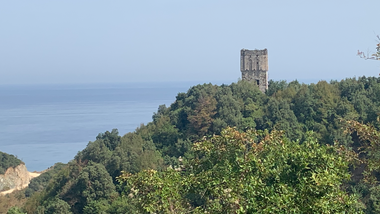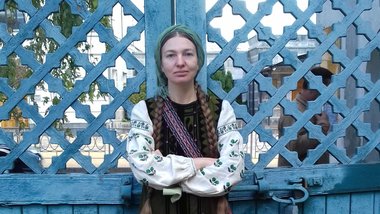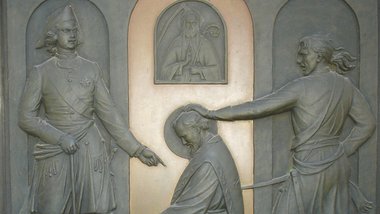Manipulating shrines
Sometimes, reports are published in the print press or the Internet, which highlight, like powerful projectors, completely ordinary events but in an entirely new dimension, the dimension of Eternity.
Serhii Tselovalnyk, head of the Urban Planning, Architecture and Design Directorate at the KMDA (Kyiv City State Administration), told Channel 2’s news service TSN that in place of the famous Church of the Tithes, located in downtown Kyiv, there would be erected a temple under the auspices of the Moscow Patriarchate; that, in response to a request filed by the Ukrainian Orthodox Church of Moscow Patriarchate, “it is suggested that a platform be constructed where [a team of] archaeologists could continue working, and where a museum could be created, while building a church on this platform. However, this will be a new construction project, not a renovated Church of the Tithes.”
For those of our readers who may not give due attention to this information and to help them judge the importance of this question, it is crucial to explain the role that the Church of the Tithes played in the life of Kyivan Rus’.
It was the first stone Eastern Orthodox cathedral (also known as the Church of the Dormition of the Virgin), ordered to be built by St. Volodymyr the Great (989-999 A.D.), who allocated one-tenth of the state revenues for its construction. Hence the temple’s name.
The Church of the Tithes (Desiatynna tserkva in Ukrainian) was a colossal monument to Eastern Europe’s Christian culture, doubtlessly the largest such structure in the 10th-11th centuries. It was destined to sustain all imaginable and unimaginable disasters and cataclysms. In 1169, the temple was looted by troops led by the son of Prince Andrei Bogolyubsky of Vladimir-Suzdal (actually, it was led by the prince) whose forces seized Kyiv, marauding and burning down a number of churches (except Desiatynna, St. Sophia, and the Kyiv Cave Monastery). The Church of the Tithes was where the most prominent princes of Kyivan Rus’ found their last respite until the Golden Horde’s onslaught. The most tragic page in Desiatynna’s history is Kyiv’s siege by Batu Khan’s forces toward the end of 1240.
After the Horde broke through Kyiv’s advance defenses, despite Kyiv’s defenders’ heroic resistance, and broke into the city, a fortification was built round the Church of the Tithes on Starokyivska Hill, where many unarmed Kyivit — women, wounded men, children, and elders — retreated. Desiatynna was the only safe place left in the blazing city, but its walls couldn’t accommodate so many people and collapsed. That was how the ancient cathedral, built by St. Volodymyr, the last fortification of Kyiv in the battle with Batu Khan, ceased to exist on December 6, 1240.
More than five years ago, The Day’s contributor Klara Gudzyk (may God rest her soul!) wrote in her article “The Church of the Tithes: A Time to Gather Stones”: “In this world some build temples and others destroy them. The Church of the Tithes was first devastated by the Tatar Mongols in the 13th century. Four hundred years later Metropolitan Petro Mohyla ordered that ‘the Holy Virgin’s Church of the Tithes next to Kyiv’s gate be dug out of obscurity and opened to the light of day.’ So, in memory of the old sanctum, a little church was built onto one of the church’s surviving walls. In 1842 a large Church of the Tithes (smaller than the one built by Prince Volodymyr) was constructed according to plans drawn up by Russian architect Stasov, only to be blown up by the Bolsheviks in 1936. Since then the 1,000-year-old church almost vanished into thin air, as if there were no more expert masters in this country, as though no one had anything to pray for beneath the majestic dome of the Church of the Tithes.”
Desiatynna’s tragic history is only one aspect — however important — to the problem. Another aspect is the future. What will happen next? This is what’s uppermost on the agenda. Getting back to where I started, any proposals, projects, practical intentions failing to bear in mind the existing tensions and ramifications in Ukraine’s interconfessional relationships, abiding by tendentious preferences in any projects aimed at renovating the Church of the Tithes, serving the interests of a certain confession or Church — worst of all ones aimed at integrating Ukraine with the so-called Russian World — would be disastrous. Worse so if it is a government-supported project, aimed at placing Desiatynna under the Ukrainian Orthodox Church of Moscow Patriarchate (UOC MP). Such a project would be shortsighted, to put it mildly, and extremely damaging and heavily politicized.
Oleksandr Palii, a noted Ukrainian political analyst, submitted an article to http://www.pravda.com.ua, eloquently entitled “Is the Golden Horde’s Yoke Still On Our Necks?” He wrote: “The decision of ‘the Ukrainian powers that be’ to give preference to a certain confession (UOC MP) is worse than stupid. The basic, established fact is that this temple was the religious center of Kyivan Rus’, when there was no Moscow/Muscovy. This is also evidence of undisguised religious discrimination. Every poll shows that there are more Kyiv Patriarchate adherents in Ukraine, compared to the UOC MP numbers. Note that, back in 2004, the Kyiv Patriarchate declared it would struggle for its right to restore the Church of the Tithes. The current decision by the Ukrainian government is provoking a very serious interconfessional conflict in the heart of the capital city.”
I would add that previously it became known that the authorities plan to pour concrete on what’s left of Desiatynna to make a foundation for what UOC MP intends to make its temple (to this end Tselovalnyk’s statement should be regarded as the proverbial harbinger).
Who knows? We could be dealing with the first tentative attempt to win public support. Some believe that the Ukrainian public is mostly concerned about problems relating to personal survival.
TO THE POINT
MYKOLA TOMENKO: WHO IS MISINFORMING THE UKRAINIAN PUBLIC?
The story about the construction of the Church of the Tithes in Kyiv is shrouded in mystery, to quote from Deputy Speaker of the Verkhovna Rada of Ukraine Mykola Tomenko, one of the leaders of the Batkivshchyna Party. According to the BYuT press service, he has received a reply to his formal inquiry as a member of the Ukrainian Parliament. Tomenko says that he has been informed by the Prime Minister and the Ministry of Culture, to the effect that the whole affair boils down to “archaeological works aimed at turning the remains of the Church of the Tithes into a museum.” The bureaucrats assure him that the information about the “construction of a new temple on the grounds of this archaeological monument of national significance, as well as the commencement of construction works, is ungrounded.”
Tomenko mentioned [in his inquiry – Ed.] that the media quoted a UOC MP official as saying that they have the blueprints for the new church to be built on a foundation made using what’s left of Desiatynna, and that this construction project will surely be carried out.
The website www.lb.ua quotes Tomenko as saying: “Two inferences: [a] the priests of the [Ukrainian Orthodox Church of the] Moscow Patriarchate don’t bother to abide by Ukrainian legislation, and [b] the central government and local authorities have made a deal with the church [i.e., UOC MP. — Ed.] and are misinforming the general public.”
Tomenko also believes that further proof that those in power are keeping the public in the dark is that the media quote Serhii Tselovalnyk as saying that “…the Ukrainian Orthodox Church under the aegis of the Moscow Patriarchate has come up with the initiative of restoring this temple. In accordance with church canons, temples are built on holy grounds, so [in this case] the site has been chosen: [the ruins of] the Church of the Tithes.” In his letter Tselovalnyk further informs that a task force has been formed, whose members will cope with their missions; that there is a “creative quest” underway to find creative solutions to the existing problems. Tomenko says he was amazed by the statements made by Kyiv’s chief architect and those by the priests, because they apparently contradicted the go-vernment’s promises. In view of this, Tomenko addressed a formal message to the Prosecutor General of Ukraine, demanding legal assessment of all actions taken by the officials concerned, in regard to the possible construction of a religious structure, under the aegis of UOC MP, on a historic archaeological site of national importance, and that all measures be taken, in keeping with prosecutorial oversight procedures.
LARYSA SKORYK: A MUSEUM INSTEAD OF A CHURCH?
Architect Larysa Skoryk says the Ukrainian Orthodox Church of Moscow Patriarchate will not build their temple in place of the Church of the Tithes:
“When discussing Desiatynna’s foundation, it was decided to turn down all options except the museum one,” reads http://rus.newsru.ua, referring to http://www.stolitsa.co.il.
“There will be a modern-equipped historical exhibit. This structure won’t even be above earth level, well maybe 50 cm above. Nothing else will be built on the site,” assures the architect Skoryk, adding that there is a task force, and they considered the option of a platform with a chapel upon it, but that they turned it down. Well, seeing is believing, considering that there has been no official information to this effect.
Ihor SIUNDIUKOV
27 January 2011 The Day









